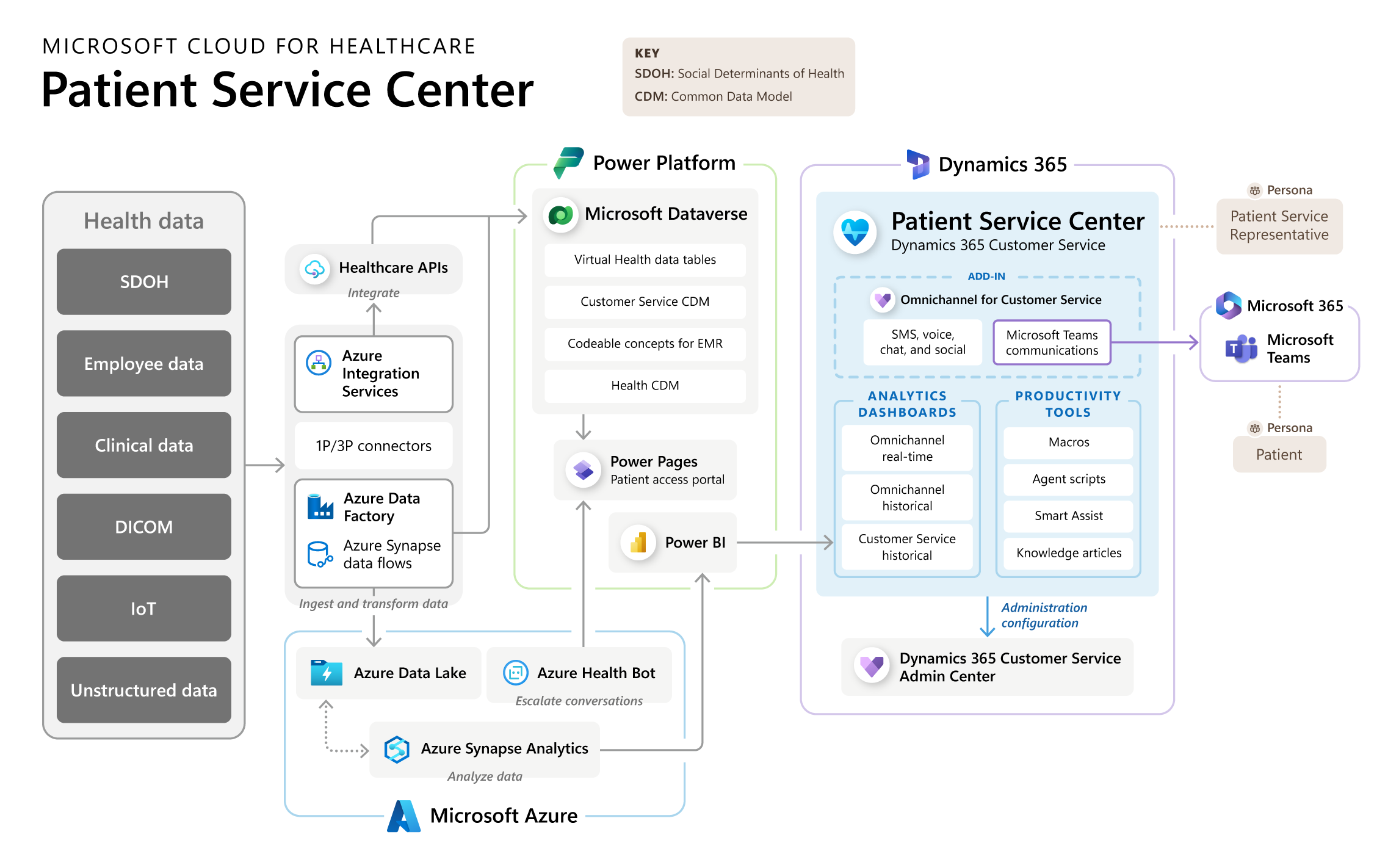Patient service center architecture
Important
Effective January 30, 2025, the patient service center solution will be retired and no longer supported.
Have questions? Reach out to us at Microsoft Cloud for Healthcare.
Patient service center allows healthcare service representatives to engage with patients through chat and monitor automatic conversations using the Microsoft Azure Health Bot service. It enhances patient experiences through personalized and secure virtual health engagements with patient guidance and embedded insights for service representatives.
Patient service center is built on the capabilities of the Common Data Model, Dynamics 365 Customer Service, Digital Messaging add-in for Dynamics 365 Customer Service, and Microsoft Power Platform. To set up the solution, use Microsoft Cloud Solution Center. It creates a Dataverse environment as part of Microsoft Power Platform and deploys the patient service center application within Dynamics 365 (and sample data and codeable concepts, if selected).
You can extend the core capabilities of patient service center by deploying and configuring more services such as Microsoft Power Pages, Azure Health Bot, Dynamics 365 Customer Voice, and Microsoft Teams.
Architecture
The following architecture diagram depicts the patient service center solution components and integrations.
Key capabilities of patient service center include:
- Patient conversation monitoring: An ongoing conversations dashboard provides information on the conversations managed by the agents and integrated bots.
- Agent scripts: Use provider-specific agent scripts to address patient issues.
- Effectiveness monitoring: Conversation intelligence provides insights for service center managers on agent performance.
- Follow-up: Send follow-up surveys on patient satisfaction, reminders on appointments, and more.
- Appointment scheduling: Schedule or reschedule appointments during conversations with patients.
- Teams calling: Direct conversation with patients to discuss availability or get details.
This article discusses the component layers which compose the patient service center solution architecture.
Security
After assigning appropriate licenses and granting environment access, you must assign extra built-in security roles to users, owner teams, or Microsoft Entra group teams to access or use the application.
- Basic user
- Customer service representative
- Omnichannel agent/supervisor/administrator
- Healthcare user or Healthcare nonclinical user
- Data integration toolkit security roles (when using the data integration toolkit or any of its components)
For access to specific features, you may need to apply more roles, including the following roles:
- Productivity tools user/administrator
- Knowledge manager, customer service manager, or customer service representative
For more information about these security roles, see Assign roles for Omnichannel for Customer Service and Create and manage knowledge articles.
For information on authentication for the patient access portal, see Overview of authentication in Power Pages.
For security information on Azure Health Bot, see Security and privacy.
User interface
Patient service center is a model-driven patient service application that builds on Dynamics 365 Customer Service and Dynamics 365 Omnichannel for Customer Service. The model-driven app comes with prebuilt workflows that assist patient appointment scheduling and satisfaction surveys. They can be further customized with templates, agent scripts, knowledge articles, macros, and more.
Integrations with other products and services can further enhance the features of patient service center, including Power Pages and Azure Health Bot. Connect patient service center to the Patient access portal built on Power Pages to create a direct channel for your patients. Configure Microsoft Azure Health Bot to automate conversations directly in the portal and escalate patient conversations to patient service representatives.
Important
Effective January 30, 2025, the patient access solution (includes patient access portal) will be retired and no longer supported.
Have questions? Reach out to us at Microsoft Cloud for Healthcare.
Patient service center uses the UI components of Omnichannel for Customer Service. After a patient conversation escalates through the Azure Health Bot to a patient service representative, the patient service center application displays the unified patient view between the collapsible productivity pane and Azure Health Bot conversation history. It also displays embedded insights and actions to help the representative properly assist the patient.
Analytics
Patient service center comes with ready-to-use extensible Power BI dashboards that provide information about key performance indicators (KPIs) for organizations and their patient service representative conversations. Learn more about Customer Service dashboards, Omnichannel for Customer Service dashboards, and the Omnichannel real-time analytics dashboard.
Related information
- Set up and configure Microsoft Cloud for Healthcare
- Use patient service center for patient engagement
- Configure automatic chats using Microsoft Azure Health Bot
